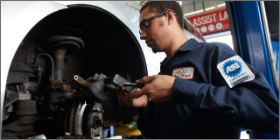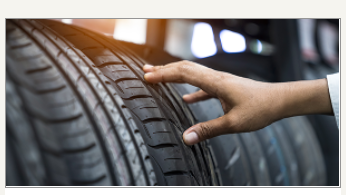Our Pep Boys Pros Are Available 7 Days a Week to Help Maintain Your Car
Tire care isn't just about inflation and rotation. It's also about understanding tire tread depth, which directly affects your vehicle's performance and safety. Here at Pep Boys, we're passionate about equipping you with the knowledge you need to take command of your tire maintenance routine. That's why we've put together this comprehensive guide on tire tread depth, providing valuable insights into why it matters, how to check it, and essential tips for maintaining it.
Understanding Tire Tread Depth
What is Tire Tread Depth?
Tire tread depth refers to the vertical measurement from the top surface of a tire's tread rubber to the bottom of its deepest grooves. It's usually measured in 32nds of an inch. The depth of your tire tread is vital to ensure your vehicle's safety on the road.
The tread depth directly influences how your tires perform, especially when it comes to grip and traction. This is why there are legal requirements in place stipulating a minimum tread depth. The U.S. Department of Transportation recommends replacing tires when they reach 2/32 inches (1.16 millimeters), and over forty states legally require tires to be replaced at this depth. However, it's not just about complying with the law but also about ensuring your safety and that of other road users.
Why is Tire Tread Depth Important?
The importance of maintaining the proper tire tread depth can't be overstated. Adequate tread depth is essential for the optimal performance of your vehicle. Tires with insufficient tread depth can negatively impact vehicle handling, compromising safety. Your tires' tread depth affects how well your vehicle can grip the road.
A greater depth allows for better traction, especially in adverse weather conditions like rain or snow. The deeper the tread depth, the better your tires can displace water or snow, reducing the risk of hydroplaning or skidding.
Checking Your Tire Tread Depth
When to Check
As part of your routine tire care, it's important to check your tire tread depth regularly. But how frequently should you be doing it? A general rule of thumb is to inspect your tires at least once a month. However, checking more often is advisable if you are a high-mileage driver or frequently travel on rough roads.
Signs indicating a need to check your tire tread depth include decreased traction increased stopping distances, and abnormal tire wear patterns. Staying proactive is important as these can point toward potential safety issues. And don't forget to adapt your tire checks according to the seasons. For instance, more regular checks are beneficial during winter when road conditions become more treacherous.
How to Check
Now, when it comes to checking tire tread depth, you have several tools at your disposal. The most accessible technique is the penny test. Insert a penny into your tire's tread grooves with Lincoln's head facing down. If you can see all of Lincoln's head, your tread depth is less than 2/32 of an inch, and it's time for new tires.
Interpreting the results of your tire tread depth check is straightforward. If the tread depth is below the legal minimum of 2/32 of an inch, your tires are no longer road-legal, and their performance in adverse conditions will be compromised. So if you're comfortable with how to read tire pressure and are confident in your tread measuring skills, you're well on your way to safer driving. However, remember that if you're in an accident caused by worn-out tires, the insurance company may argue that you were negligent in maintaining their vehicle and deny your claim.
For a more thorough inspection, consider getting your tire tread depth checked professionally while doing other maintenance work. Professionals can provide a more detailed analysis and help you better understand your tires' overall health.
Maintaining Proper Tire Tread Depth
Tire Rotation
One of the key aspects of tire maintenance that ensures even tread wear is tire rotation. How to rotate your tires is a process that involves moving your tires from one position on your vehicle to another to ensure balanced wear and tear. To perform this, you'd need some basic tools like a car jack, and jack stands. Ideally, you should rotate your tires every 5,000 to 7,500 miles, but always check your vehicle's owner's manual for specific recommendations, as these are by no means universal guidelines. The make and model of your vehicle, as well as your driving habits, will further determine tire rotation frequency. While rotating your tires, always remember to practice safety first. If you're unsure, bringing your vehicle to a professional tire service is best. They're equipped with the right tools and expertise to get the job done correctly and safely.
Proper Tire Inflation
Correct tire inflation is paramount in ensuring optimal tread wear. Under-inflated or over-inflated tires can lead to uneven tire wear, compromised vehicle handling, and even a potential blowout. Make it a habit to check your tire pressure at least once a month and before long trips. A simple tire pressure gauge is a valuable tool in this regard. If you're uncertain, don't hesitate to bring your vehicle to professional tire services to ensure correct tire pressure. They can also provide you with personalized tips on maintaining proper tire inflation levels.
Proper Vehicle Load
Believe it or not, your vehicle's load also impacts tire wear. Overloading your vehicle can cause excessive strain on your tires, leading to quicker tread wear. Always adhere to your vehicle manufacturer's guidelines regarding maximum load capacity. Especially for vehicles like pickup trucks, avoid carrying unnecessary loads. If your work or personal vehicle often carries large loads, inspect your tires more frequently.
Location, Location, Location
The surface you drive on significantly affects your tire wear. Rough or uneven surfaces can lead to premature and irregular tread wear. Examples of such terrains include gravel roads, construction sites, and off-road trails. If it's unavoidable, like if you live on a country road, make sure to inspect your tires more frequently. A little mindfulness can help extend the life of your tires and ensure a safer driving experience.
Match Tires to Driving Conditions
Choosing the right tires for your vehicle and driving conditions not only ensures optimal performance but can also help prolong the life of your tires. Remember, not all tires are created equal — they're designed with specific conditions and requirements in mind. Let's take a closer look at different tire types and their tread depths:
- All-season tires: Designed to handle various driving conditions — snow, rain, heat, and cold — they are typically equipped with a tread depth of around 10/32 inches. These tires offer a blend of performance traits thanks to their versatile design.
- Summer tires: Optimized for excellent road grip, cornering, braking, and acceleration, they are designed for warmer conditions or regions that experience nothing more than an infrequent downpour. They feature a shallower tread depth of around 8/32 inches, maximizing road contact and enhancing handling capabilities.
- Winter tires: Perfect for tackling snowy and icy conditions, they have a deeper tread depth of around 11/32 inches, which delivers superior traction on slippery surfaces. The unique tread patterns further enhance their grip on snow and ice.
- Touring tires: Ideal for long-distance and highway cruising, these tires balance comfort, fuel efficiency, and reliability. Commonly found on sedans, minivans, and crossovers, they offer a tread depth of around 9/32 inches, optimizing smoothness over high-performance handling.
- All-terrain tires: These tires are designed to handle a variety of off-road conditions, such as dirt, sand, and gravel. They come with a deeper tread depth of approximately 12/32 inches for better grip on uneven surfaces.
- Mud-terrain tires: Designed to conquer muddy off-road trails, these tires feature a deep tread depth of around 15/32 inches, providing superior traction in mud and other soft surfaces.
- Racing tires: These are specialized tires for high-speed racing, designed to offer maximum grip and handling. They come with a very shallow tread depth of about 4/32 inches to maximize track contact.
Understanding Tire Wear Patterns
Decoding Tire Wear Patterns
Just as a doctor can learn a lot from a patient's symptoms, tire wear patterns can reveal a great deal about your vehicle's health and your driving habits. How your tires wear down is not random — it's influenced by various factors, from tire inflation to alignment and balance. When these factors are not optimal, irregular wear patterns can emerge, which can, in turn, impact your tire's tread depth and overall performance.
Spotting Irregular Wear Patterns
To safeguard your tire's tread depth, it's wise to keep an eye out for these irregular wear patterns. Understanding these signs and acting swiftly to correct the underlying issues can protect the longevity of your tires and ensure a safer driving experience.
- One-sided wear: This wear pattern indicates that the tire is wearing down more on one side than the other. This can be caused by an alignment issue or worn suspension components.
- Shoulder step wear: This wear pattern appears as a step-like wear on the shoulder of the tire. It can be caused by improper alignment, worn suspension components, or overloading the vehicle.
- Erosion/river wear: This wear pattern appears as a series of grooves or channels on the tire tread. It can be caused by driving on rough or uneven surfaces, such as gravel or dirt roads.
- Depression wear: This wear pattern appears as a series of dips or depressions in the tire tread, either in the center, intermediate, or shoulder areas. It can be caused by overloading the vehicle, improper alignment, or worn suspension components.
- Diagonal wear: This wear pattern appears as a series of diagonal grooves across the tire tread. It can be caused by improper alignment or worn suspension components.
- Radial feather wear: This pattern appears to be slanted chisel-like wear on the tire tread. It can be caused by excessive toe-in or toe-out alignment.
- Multiple flat spotting wear: This wear pattern appears as multiple flat spots around the tire tread. It can be caused by locking up the brakes or skidding the tires.
- Cupping wear: This wear pattern appears as a series of scalloped dips on the tire tread. It can be caused by worn suspension components, out-of-balance tires, or improper alignment.
- Patch wear: This pattern appears patchy, with uneven wear on the tire tread. It can be caused by improper alignment or out-of-balance tires.
Alignment, Suspension, and Safety
As you can see, your vehicle's alignment and suspension components are crucial in maintaining even tire wear and, consequently, appropriate tread depth. Misalignment can result in uneven tire wear, reducing the lifespan of your tires and potentially leading to hazardous driving conditions. Similarly, worn or damaged suspension parts can lead to irregular tire wear patterns. Ignoring these signs shortens your tires' life and compromises your safety on the road. That's why it's so important to regularly check your tires and address any issues promptly.
When to Replace Your Tires
When it comes to deciding when to replace your tires, safety should be your primary concern. In general, it's time to start shopping for new tires before your tread depth measures 2/32 of an inch or less. Remember that this measurement isn't just a suggestion — it's a legal requirement in many states. Remember that different driving conditions and habits can accelerate tire wear, making it smart to replace them before they reach this minimum tread depth. Regular inspections by professional tire services can offer invaluable guidance on when it's time for a change.
When that time comes, choosing new tires for your vehicle is a big decision. Consider factors like the type of vehicle you drive, the climates and terrains you frequently encounter, and your driving habits. And remember, you don't have to navigate this process alone. You can search tire shops near me to find a Pep Boys location near you. Our friendly, knowledgeable team can guide you through the process, ensuring you make a selection that offers both safety and performance. Our priority is your satisfaction, and we're here to help make your tire replacement journey as smooth as possible.
Final Word on Tire Tread Depth: Charting a Course to Improved Tire Safety
The importance of maintaining proper tire tread depth cannot be overstated. A healthy tread depth ensures reliable vehicle performance and your safety on the road. While taking charge of your tire care is empowering, remember that professional tire services can help maintain and check tread depth. At Pep Boys, we're not just experts — we're your trusted advisors, ready to assist you in all things automotive. Use the knowledge you've gained from this post, and remember, we're here to help you find and maintain the perfect tires. You're not alone on this journey. Stay safe, be proactive, and let's drive towards a safer future together.






